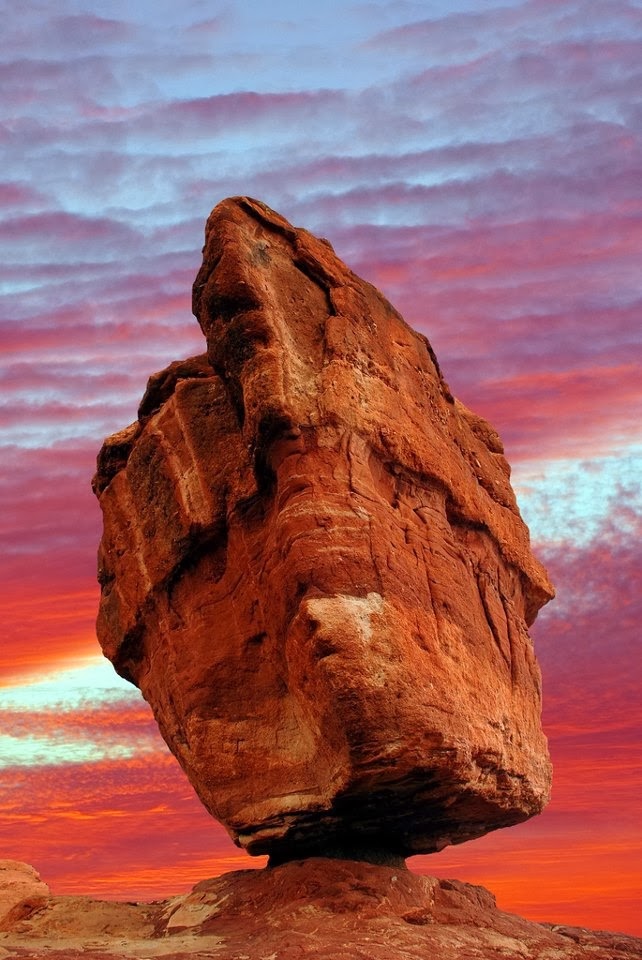Garden of the Gods is a public park located in Colorado Springs, Colorado, USA. It was designated a National Natural Landmark in 1971.The Garden of the Gods red rock formations were created during a geological upheaval along a natural fault line millions of years ago. Archaeological evidence shows that prehistoric people visited Garden of the Gods about 1330 BC. About 250 BC Native American people camped in the park. They are believed to have been attracted to wildlife and plant life in the area and used overhangs created by the rocks for shelter. There are many native peoples who have reported a connection to Garden of the Gods, including Ute, Comanche, Apache, Kiowa, Shoshone, Cheyenne, Pawnee and Lakota people.The Utes oral traditions tell of their creation at the Garden of the Gods. Petroglyphs have been found in the park that are typical of early Utes. They found red rocks to have a spiritual connection and camped near Manitou Springs and the creek near Rock Ledge Ranch bordering Garden of the Gods. Other tribes traveled through Garden of the Gods.The Old Ute Trail went past Garden of the Gods to Ute Pass and led later explorers through Manitou Springs. Starting in the 16th century, Spanish explorers and later European American explorers and trappers traveled through the area, including Lt. John C. Freemont and Lt. George Frederick Ruxton who recorded their visits in their journals.The area was first called Red Rock Corral.Then, in August 1859, two surveyors who helped to set up Colorado City explored the site. One of the surveyors, M. S. Beach, suggested that it would be a "capital place for a beer garden." His companion, the young Rufus Cable, awestruck by the impressive rock formations, exclaimed, "Beer Garden! Why it is a fit place for the gods to assemble. We will call it the Garden of the Gods."In 1879, Charles Elliott Perkins, a friend of William Jackson Palmer, purchased 480 acres of land that included a portion of the present Garden of the Gods. Upon Perkin’s death, his family gave the land to the City of Colorado Springs in 1909, with the provision that it would be a free public park. Palmer had owned the Rock Ledge Ranch and upon his death it was donated to the city.Helen Hunt Jackson wrote of the park, "You wind among rocks of every conceivable and inconceivable shape and size... all bright red, all motionless and silent, with a strange look of having been just stopped and held back in the very climax of some supernatural catastrophe."Having purchased additional surrounding land, the City of Colorado Springs' park grew to 1,364 acres. In 1995 the Garden of the Gods Visitor and Nature Center was opened just outside of the park.The outstanding geologic features of the park are the ancient sedimentary beds of deep-red, pink, and white sandstones, conglomerates and limestone that were deposited horizontally, but have now been tilted vertically and faulted by the immense mountain building forces caused by the uplift of the Rocky Mountains and the Pikes Peak massif. The following Pleistocene Ice Age resulting in erosion and glaciation of the rock, creating the present rock formations. Evidence of past ages; ancient seas, eroded remains of ancestral mountain ranges, alluvial fans, sandy beaches and great sand dune fields can be read in the rocks.The resulting rocks had different shapes: toppled, overturned, stood-up, pushed around and slanted. Balanced Rock, a Fountain formation, is a combination of coarse sand, gravel, silica and hematite. It is hematite that makes the large balancing rock rock red. It toppled off of a ledge, rested on sand that was worn away at the base. Gateway Rock and Three Graces are stood-up rocks that had been pushed up vertically. The Tower of Babel is Lyons formation, a stone made of fine sand from an ancient beach.The Garden of the Gods Park is a rich ecological resource. Retired biology professor Richard Beidleman notes that the park is "the most striking contrast between plains and mountains in North America" with respect to biology, geology, climate, and scenery. Dinosaur species Theiophytalia kerri was found in the park in 1878, and studies of the skull in 2006 reveal it to be a new species. A honey ant never before recorded was also discovered in 1879 and named for the park. Mule deer, bighorn sheep, and fox abound in this area. The park is also home to more than 130 species of birds including white-throated swifts, swallows and canyon wrens.
Source:
Picture:Link:
Wikipedeia:Link:

0 comments:
Post a Comment